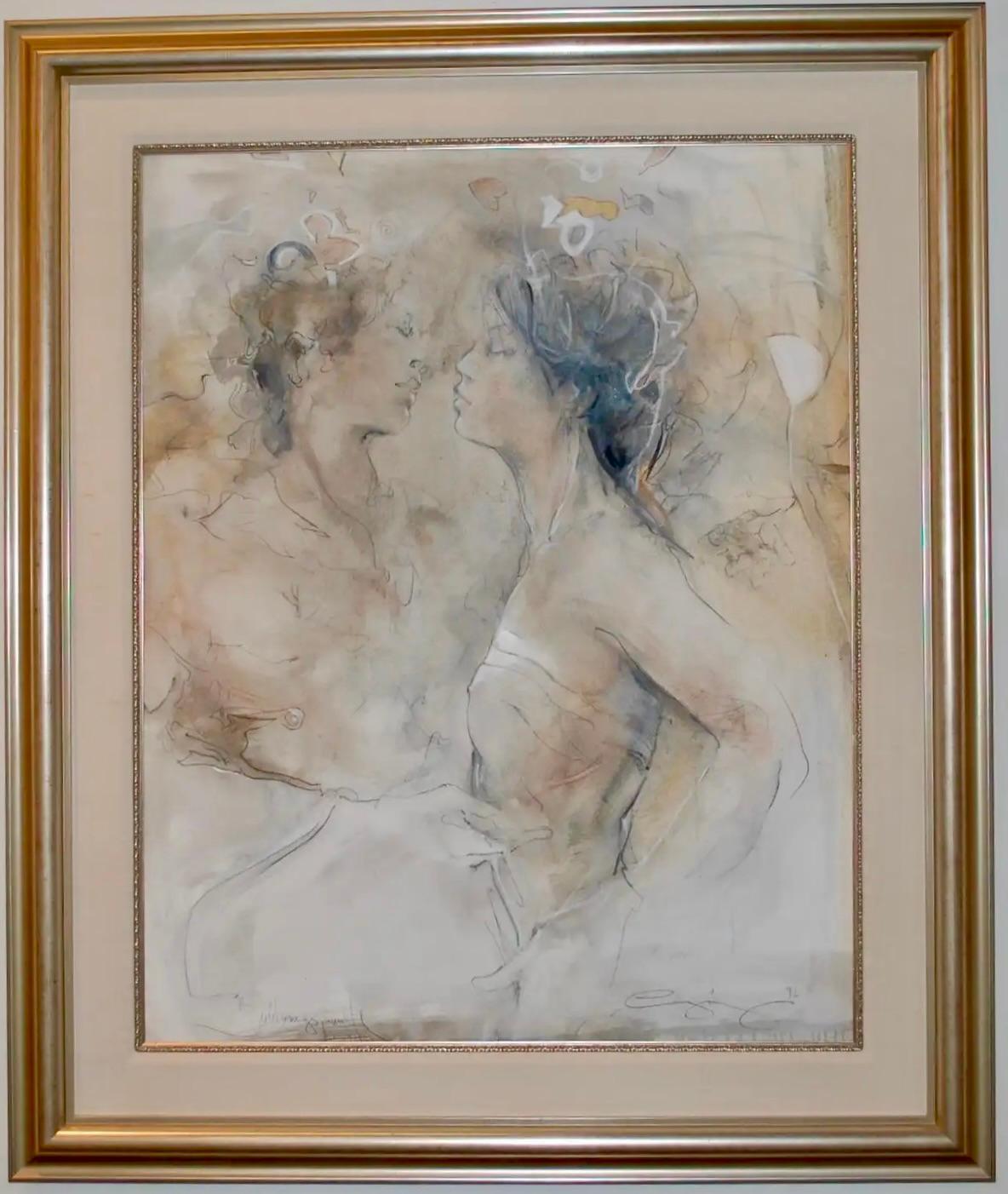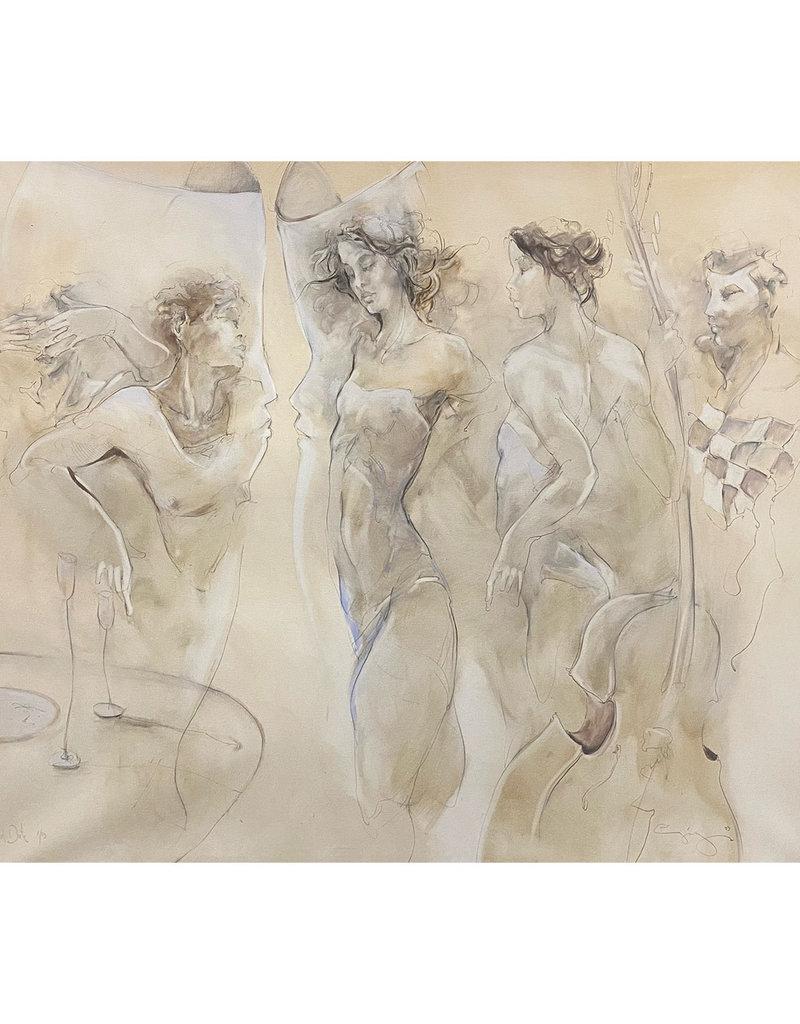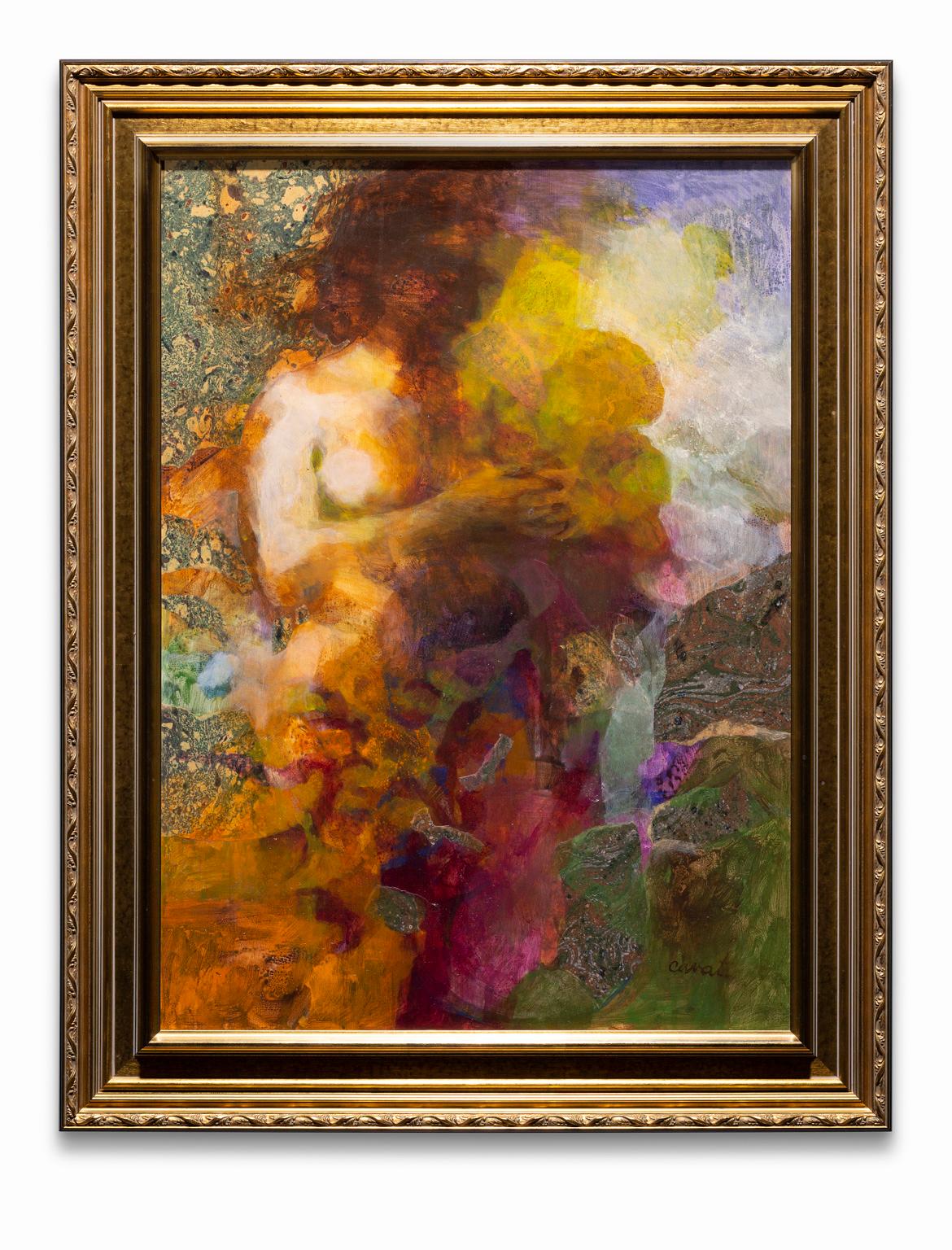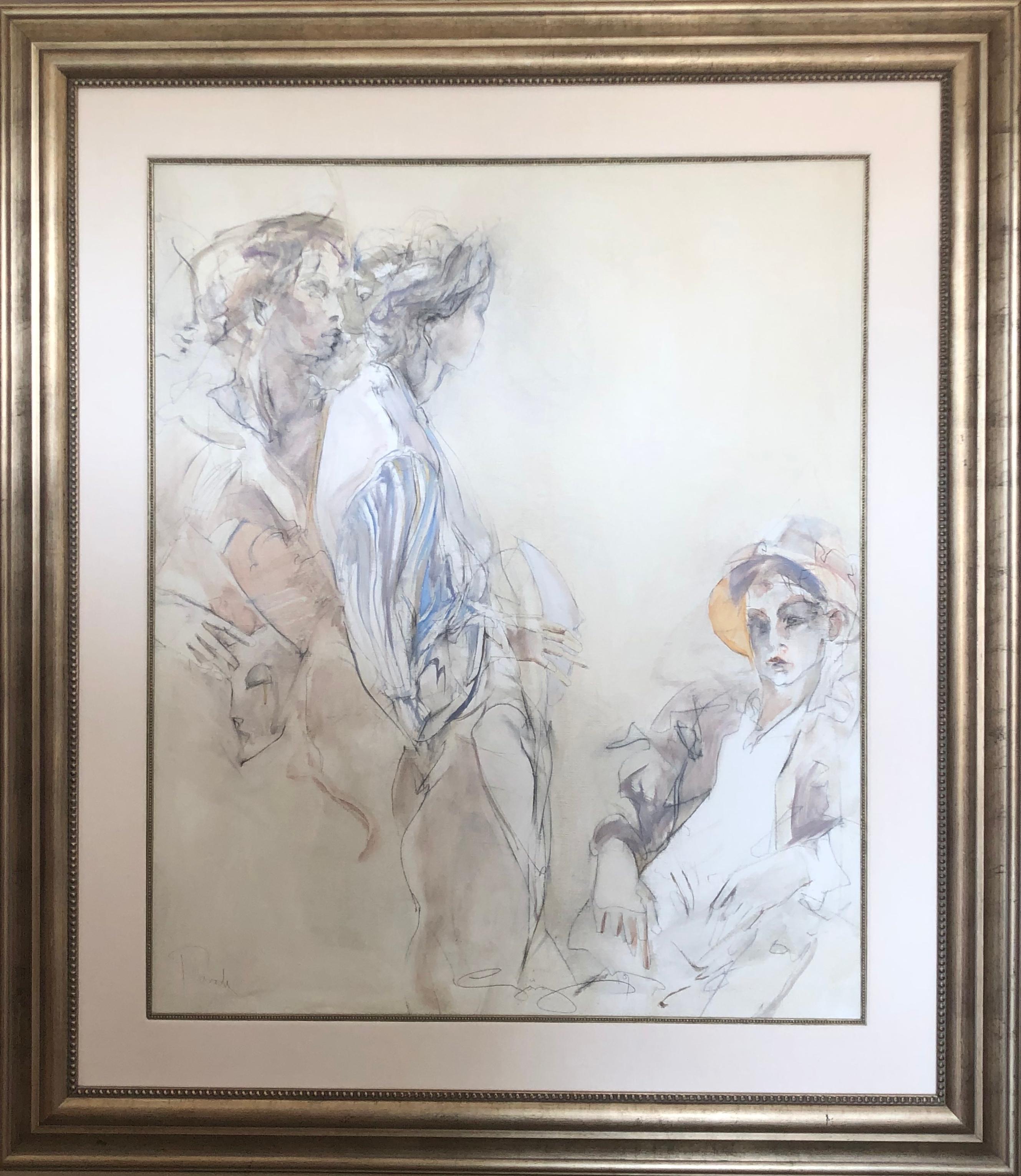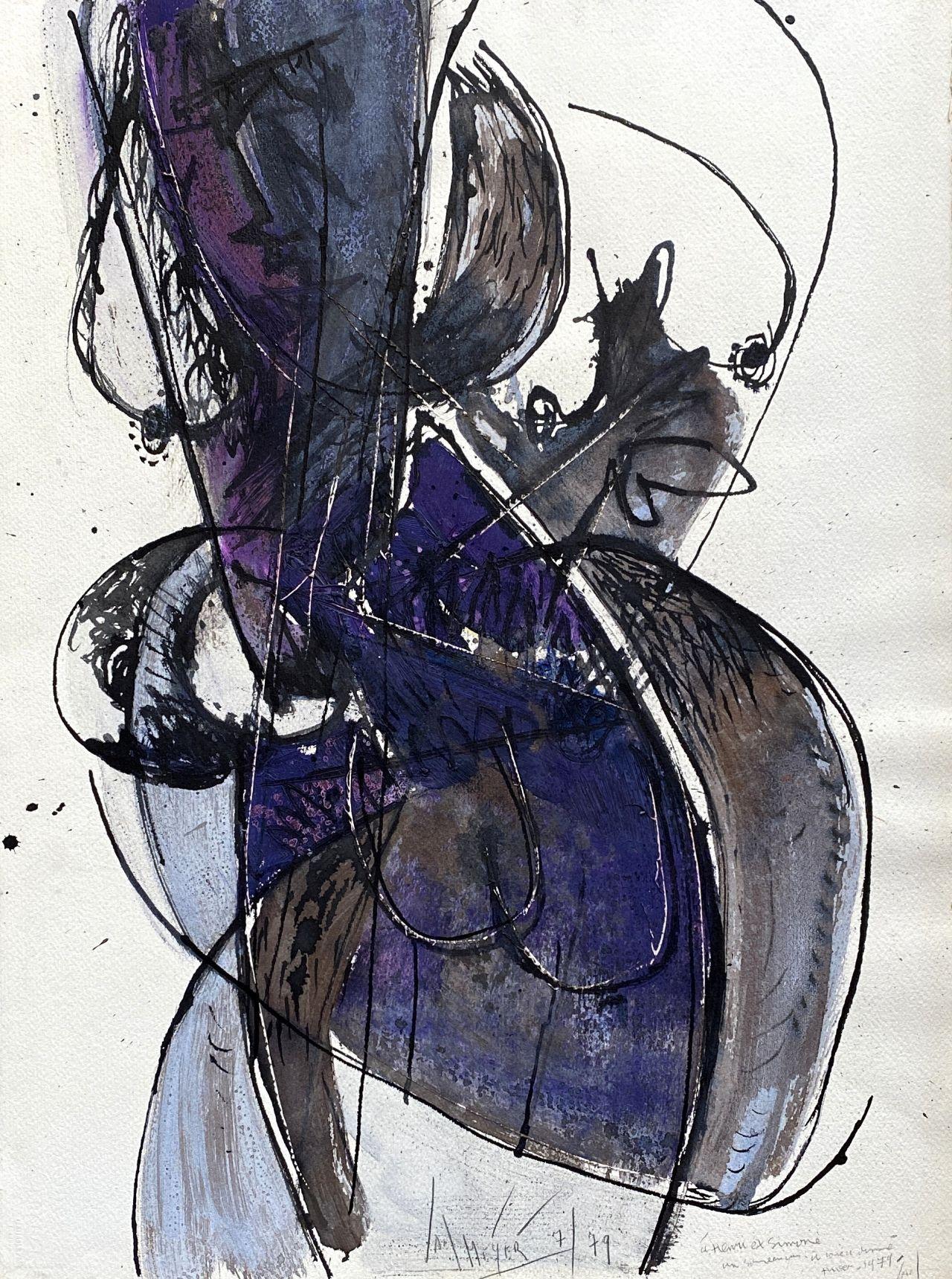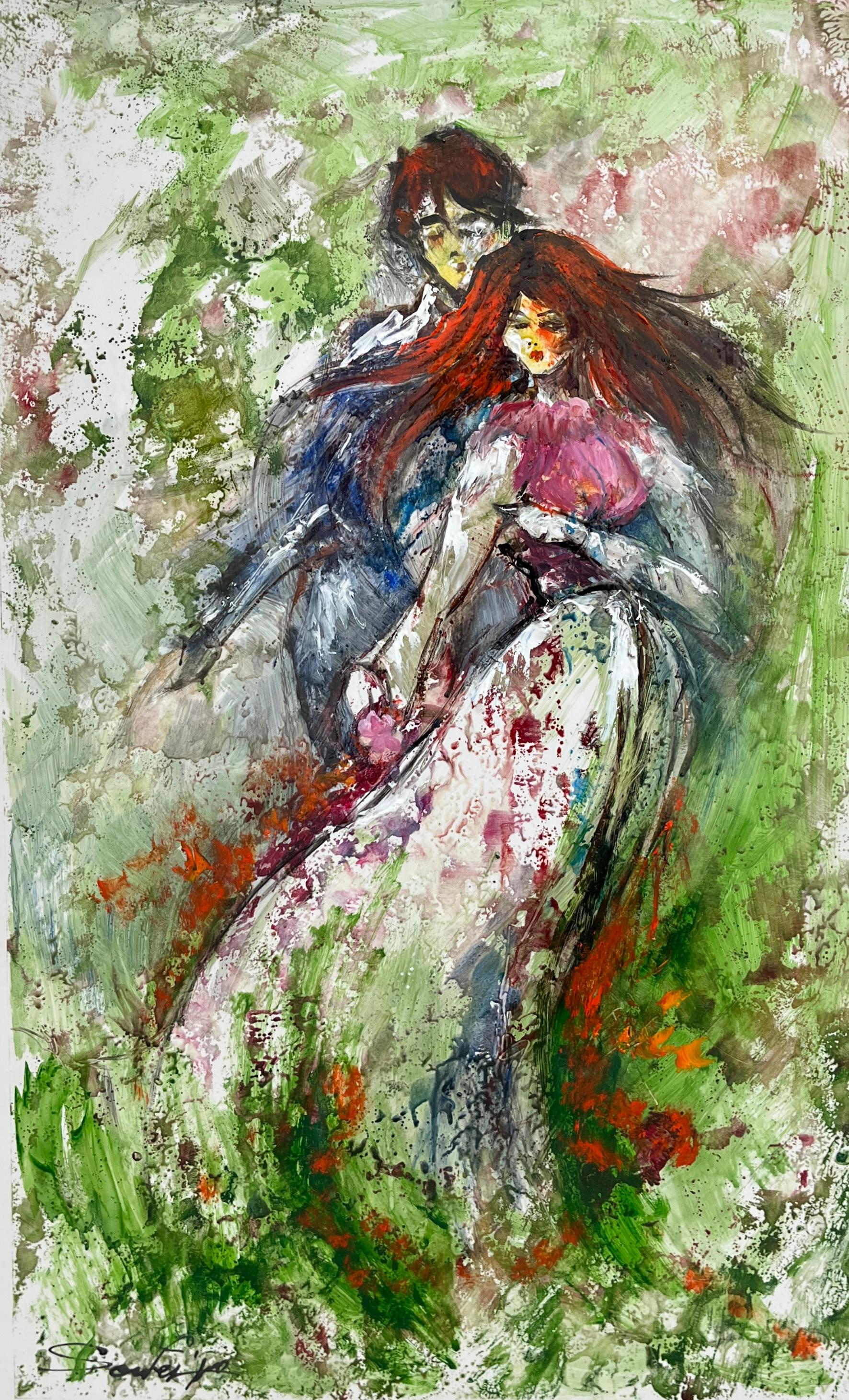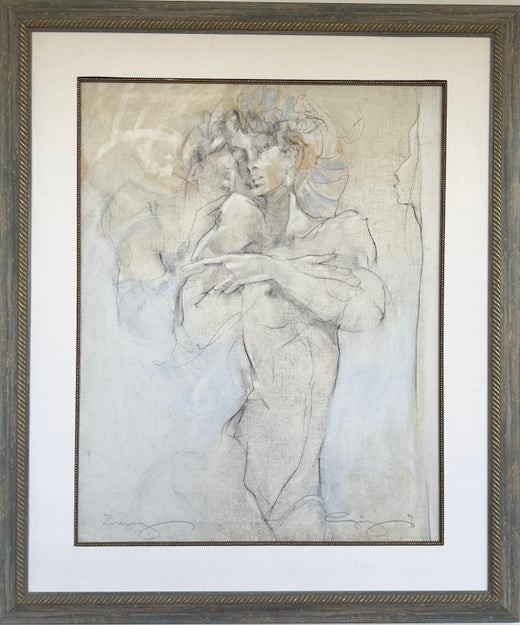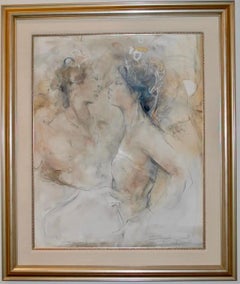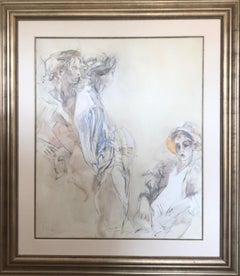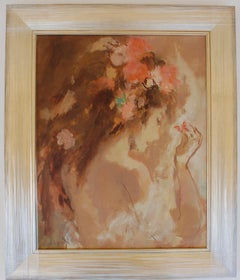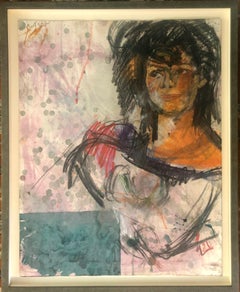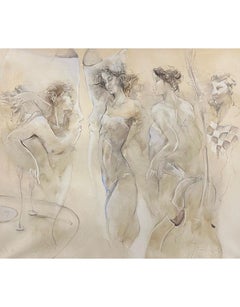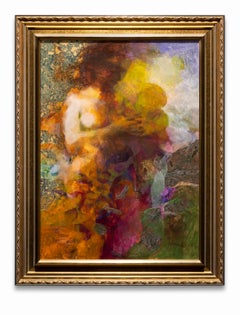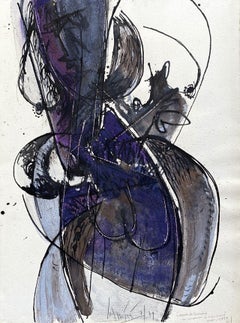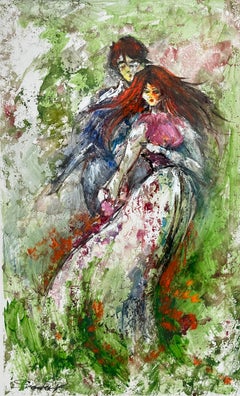Items Similar to Affection Mixed Media
Want more images or videos?
Request additional images or videos from the seller
1 of 11
Jürgen GörgAffection Mixed Media1989
1989
$11,000
£8,354.77
€9,652.52
CA$15,416.90
A$17,254.41
CHF 9,005.47
MX$210,414.83
NOK 115,257.82
SEK 109,106.29
DKK 72,035.49
Shipping
Retrieving quote...The 1stDibs Promise:
Authenticity Guarantee,
Money-Back Guarantee,
24-Hour Cancellation
About the Item
Affection 1989
Artist signed lower right
Oil, graphite on linen canvas 38x30, framed 52x44 inches.
Jurgen Gorg was born in 1951 in, Dernbach Germany. His formative years were spent in Koblentz, before moving to Maintz to study at the Johannes Guttenberg University. He has happy memories of his student days, particularly of his teacher Saalfield for motivating him to draw with academic precision - a skill and gift his works still possess to this day.
Gorg captivates with the line of his drawings. He combines the mastery of the classical line, as found in the Italian Renaissance, with a very modern interpretation and use. The viewer becomes caught in the movement. The melodic flow reminds one of jazz and the improvisational quality of the departure from and returns to a simple melody. Space is explored, filled, and accented all executed with a lyrical, subtle, and delicate fluidity. Most often Görg uses a monochromatic palette. Soft color is applied with graphite in combination with the translucent layers of oil. Shading is subtle - white highlights focus attention, as does the sparing use of bright color. As his mind flows, his hand follows.
The human body is the predominant image portrayed by Gorg. His artistic universe consists of lovers, dancers, musicians, and masked personages. Tender, lithe, slim, and youthful, these idealized, loosely rendered figures suggest the timeless and eternal.
The focus of his works centers on body language and kinetic movement. By leaving the faces vague, with eyes almost always closed, there is room for dreaming both in the viewer and in the subjects of the painting. This quality of the somewhat indefinite, yet perfect form, creates a romantic aura.
- Creator:Jürgen Görg (1951, German)
- Creation Year:1989
- Dimensions:Height: 52 in (132.08 cm)Width: 44 in (111.76 cm)Depth: 1 in (2.54 cm)
- Medium:
- Movement & Style:
- Period:
- Condition:
- Gallery Location:Lake Worth Beach, FL
- Reference Number:1stDibs: LU192215843432
Jürgen Görg
Born in Dermbach, West Germany in 1951, Gorg's formative years were spent in Koblenz before moving to Mainz to study at the Johannes - Guttenberg University for four years. He has happy memories of his student days and in particular, of his teacher Saalfield, who motivated him to draw with academic precision, a skill which contributes to the quality of his work today. Jurgen Gorg has been a painter professionally since 1977. He is a master craftsmen who creates etchings and lithographs. He uses a monochromatic palette in his oil paintings combined with graphite. Gorg’s paintings, drawings, graphic works and sculptures are widely exhibited throughout Germany, Switzerland, England and Japan.
About the Seller
5.0
Platinum Seller
Premium sellers with a 4.7+ rating and 24-hour response times
Established in 2004
1stDibs seller since 2015
328 sales on 1stDibs
Typical response time: <1 hour
- ShippingRetrieving quote...Shipping from: Lake Worth, FL
- Return Policy
Authenticity Guarantee
In the unlikely event there’s an issue with an item’s authenticity, contact us within 1 year for a full refund. DetailsMoney-Back Guarantee
If your item is not as described, is damaged in transit, or does not arrive, contact us within 7 days for a full refund. Details24-Hour Cancellation
You have a 24-hour grace period in which to reconsider your purchase, with no questions asked.Vetted Professional Sellers
Our world-class sellers must adhere to strict standards for service and quality, maintaining the integrity of our listings.Price-Match Guarantee
If you find that a seller listed the same item for a lower price elsewhere, we’ll match it.Trusted Global Delivery
Our best-in-class carrier network provides specialized shipping options worldwide, including custom delivery.More From This Seller
View AllTwo Figures
By Jürgen Görg
Located in Lake Worth Beach, FL
Two Figures
oil, graphite on linen canvas 40x30 framed.
Jurgen Gorg was born in 1951 in, Dernbach Germany. His formative years were spent in Koblentz, before moving to Maintz to s...
Category
1980s Expressionist Figurative Paintings
Materials
Linen, Oil, Graphite
$10,280
Parade Large Oil Painting
By Jürgen Görg
Located in Lake Worth Beach, FL
"Parade"
Oil, graphite on linen canvas, canvas 46x39 with frame 63x55.
Jurgen Gorg was born in 1951 in Dernbach Germany. His formative years were spent in Koblentz, before moving ...
Category
1980s Expressionist Figurative Paintings
Materials
Linen, Oil, Graphite
Dream Mystique
By Wallace Bassford
Located in Lake Worth Beach, FL
Dream Mystique
Artist signed and titled, new frame canvas 24x20
Wallace Bassford was an American painter and illustrator, born in 1900 in St. Louis Missouri, he attended the St. Loui...
Category
1970s Expressionist Figurative Paintings
Materials
Canvas, Oil
Portrait of A Young Woman Work On Paper
By Alexander Rutsch
Located in Lake Worth Beach, FL
Young Model II Expressionist Portrait
Rutsch is always "scribbling and scrabbling." He is an artist of the purest breed—an artist who has no choice but to paint. He is a chosen traveler of the depths of existence; a man who follows a longing to explore his inner self and relate his findings with the energy and identity of the universe.
The celebrated Austrian artist approaches painting and sculpture as he lives life—with the eyes of a child and the hand of a poet. Constantly in the quest for rhythms of form and vibrations of color, he catches those "sparks in the shadow" and evidences their fullest reality and beauty in his creations.
Each of his paintings is a careful construction as it is a spontaneous act of love. While he might attribute certain artistic expressions to "coincidence," his inspiration comes from such diverse sources as: memories, dreams, sounds, numbers, telephone poles and drift wood. Rutsch has an affinity to vibrant colors, strong contours and rich brush strokes which are apparent in his oils, mixed media works and ink drawings. He has a sensitivity to the unusual, the discarded and a fondness for the ugly as well as the chaotic. These, he often transforms into poignant welded steel abstractions.
Rutsch has an aversion to politics, citing dates and expounding upon honors achieved. There is no talk about 'profound symbolism' in his work and as Carlo McCormick writes in the introduction to Rutsch's monograph, "Meaning is not a seed that Rutsch plants, nurtures and then harvests. It is what grows wild in a volcanic swamp of fossilized, decaying and new-born fancies—as an afterthought and aftershock." Alexander Rutsch is not concerned with interpretations; he is, however, passionate about the process of making art and surrenders his entire being as an instrument to the act of creation.
The geometry of his imagination overflows with figures, profiles and penetrating strong eyes—windows to a deeper place. Their vitality and sensuality pulsate through the "dreamscapes" of Rutsch's created worlds. At times romantic, yet always wild with energy, human forms and experiences are essential to the artist's vocabulary.
The son of opera singers and a singer himself, Rutsch speaks of "the art of painting as the art of silence" and the job of the painter "to dedicate himself to the silence." He adds though, "that this silence is the greatest existing sound in the universe." One wonders why then, if painting is "the art of silence," that Rutsch's paintings scream with sound. Sometimes melancholy, sometimes sensual, sometimes dissonant and sometimes whispering, the rhythms are always rich in the celebration of life and our shared humanity.
Painter, sculptor and poet, Rutsch's oeuvre over the past four decades is tremendous. Celebrated and collected especially in Vienna, Paris, Brussels and New York, he studied with renowned teachers like Boeckl and Dorowsky and collaborated with such geniuses as Salvador Dali. Having left Vienna in the fifties, Rutsch moved to Paris and took the city's art scene by storm. There, Picasso was so enthralled with a portrait Rutsch has done of him that, in a state of great excitement, he countersigned it.
Biography
Alexander Rutsch was born in Russia in 1916 but raised in Belgrade, Yugoslavia. After studying voice in Austria he became an opera singer like his parents, but after WWII, Rutsch's love for visual expression propelled him to change careers. He was a painter, sculptor, philosopher, musician, singer and poet. His life as a romantic is reflected in his work, as he sought to perfect his soul and humanity, "I paint my dreams," said Rutsch.
"My dreams are color and life. They soar in my head like millions of symphonies. I can never stop building dreams."
In 1952, after studying under Josef Dobrowsky, Josef Hoffmann and Herbert Boeckl at the Vienna Academy of Fine Arts, Alexander Rutsch received a scholarship to study in France. There he made contacts and began collaborations with his contemporaries, Picasso and Dali. Rutsch said of his experiences with Picasso, "Picasso played a short but important moment in my life in Paris that affected my entire artistic future. I learned from him that it is not important if art is not aesthetically finished. It can be raw, uncooked, rough. If an artist feels he has said it—it is not important to polish or finish it. Because of Picasso, I learned that if I don't feel the need to finish—I don't have to." In 1954 he exhibited his work at the Salon Artistique International de Saceux and won first prize for abstract painting, the first of may awards received during his prolific career.
During the 13 years he lived in Paris, Rutsch exhibited in many prominent galleries there and throughout Europe. In 1958, The City of Paris awarded him the prestigious Arts, Science and Letters Silver Medal. In 1966, Jean Desvilles presented his prize winning film "Le Monde de Rutsch" at the Cannes Film Festival and the Venice Biennial. In 1968 Rutsch moved to Pelham, New York where he continued to work in his studio and exhibit in galleries and museums worldwide.
Rutsch's work, as seen through his mastery of many art forms—sculpture, painting, print-making, and drawing, and a wide variety of other media has been described as "vibrating showers of lines, bold geometries, wounded anatomically rambling scrap-wood skeletons...
Category
1980s Expressionist Mixed Media
Materials
Charcoal, Oil Pastel, Watercolor
Sweet Emotions Mixed Media on Paper
By Malgosia Kiernozycka
Located in Lake Worth Beach, FL
Sweet Emotions
Mixed media acrylic, watercolor, ink marker, pastel on archival.
Malgosia Kiernozycka was born in Wroclaw, Poland. She graduated high school at the School of Fine Art...
Category
2010s Abstract Expressionist Mixed Media
Materials
Ink, Mixed Media, Acrylic, Archival Paper, Pastel
Young Woman Portrait Mixed Media On Paper
By Alexander Rutsch
Located in Lake Worth Beach, FL
Young Model Expressionist Portrait
Rutsch is always "scribbling and scrabbling." He is an artist of the purest breed—an artist who has no choice but to paint. He is a chosen traveler of the depths of existence; a man who follows a longing to explore his inner self and relate his findings with the energy and identity of the universe.
The celebrated Austrian artist approaches painting and sculpture as he lives life—with the eyes of a child and the hand of a poet. Constantly in the quest for rhythms of form and vibrations of color, he catches those "sparks in the shadow" and evidences their fullest reality and beauty in his creations.
Each of his paintings is a careful construction as it is a spontaneous act of love. While he might attribute certain artistic expressions to "coincidence," his inspiration comes from such diverse sources as: memories, dreams, sounds, numbers, telephone poles and drift wood. Rutsch has an affinity to vibrant colors, strong contours and rich brush strokes which are apparent in his oils, mixed media works and ink drawings. He has a sensitivity to the unusual, the discarded and a fondness for the ugly as well as the chaotic. These, he often transforms into poignant welded steel abstractions.
Rutsch has an aversion to politics, citing dates and expounding upon honors achieved. There is no talk about 'profound symbolism' in his work and as Carlo McCormick writes in the introduction to Rutsch's monograph, "Meaning is not a seed that Rutsch plants, nurtures and then harvests. It is what grows wild in a volcanic swamp of fossilized, decaying and new-born fancies—as an afterthought and aftershock." Alexander Rutsch is not concerned with interpretations; he is, however, passionate about the process of making art and surrenders his entire being as an instrument to the act of creation.
The geometry of his imagination overflows with figures, profiles and penetrating strong eyes—windows to a deeper place. Their vitality and sensuality pulsate through the "dreamscapes" of Rutsch's created worlds. At times romantic, yet always wild with energy, human forms and experiences are essential to the artist's vocabulary.
The son of opera singers and a singer himself, Rutsch speaks of "the art of painting as the art of silence" and the job of the painter "to dedicate himself to the silence." He adds though, "that this silence is the greatest existing sound in the universe." One wonders why then, if painting is "the art of silence," that Rutsch's paintings scream with sound. Sometimes melancholy, sometimes sensual, sometimes dissonant and sometimes whispering, the rhythms are always rich in the celebration of life and our shared humanity.
Painter, sculptor and poet, Rutsch's oeuvre over the past four decades is tremendous. Celebrated and collected especially in Vienna, Paris, Brussels and New York, he studied with renowned teachers like Boeckl and Dorowsky and collaborated with such geniuses as Salvador Dali. Having left Vienna in the fifties, Rutsch moved to Paris and took the city's art scene by storm. There, Picasso was so enthralled with a portrait Rutsch has done of him that, in a state of great excitement, he countersigned it.
Biography
Alexander Rutsch was born in Russia in 1916 but raised in Belgrade, Yugoslavia. After studying voice in Austria he became an opera singer like his parents, but after WWII, Rutsch's love for visual expression propelled him to change careers. He was a painter, sculptor, philosopher, musician, singer and poet. His life as a romantic is reflected in his work, as he sought to perfect his soul and humanity, "I paint my dreams," said Rutsch.
"My dreams are color and life. They soar in my head like millions of symphonies. I can never stop building dreams."
In 1952, after studying under Josef Dobrowsky, Josef Hoffmann and Herbert Boeckl at the Vienna Academy of Fine Arts, Alexander Rutsch received a scholarship to study in France. There he made contacts and began collaborations with his contemporaries, Picasso and Dali. Rutsch said of his experiences with Picasso, "Picasso played a short but important moment in my life in Paris that affected my entire artistic future. I learned from him that it is not important if art is not aesthetically finished. It can be raw, uncooked, rough. If an artist feels he has said it—it is not important to polish or finish it. Because of Picasso, I learned that if I don't feel the need to finish—I don't have to." In 1954 he exhibited his work at the Salon Artistique International de Saceux and won first prize for abstract painting, the first of may awards received during his prolific career.
During the 13 years he lived in Paris, Rutsch exhibited in many prominent galleries there and throughout Europe. In 1958, The City of Paris awarded him the prestigious Arts, Science and Letters Silver Medal. In 1966, Jean Desvilles presented his prize winning film "Le Monde de Rutsch" at the Cannes Film Festival and the Venice Biennial. In 1968 Rutsch moved to Pelham, New York where he continued to work in his studio and exhibit in galleries and museums worldwide.
Rutsch's work, as seen through his mastery of many art forms—sculpture, painting, print-making, and drawing, and a wide variety of other media has been described as "vibrating showers of lines, bold geometries, wounded anatomically rambling scrap-wood skeletons...
Category
1980s Expressionist Portrait Paintings
Materials
Charcoal, Oil Pastel, Watercolor, Archival Paper
You May Also Like
Untitled
By Jürgen Görg
Located in Toronto, ON
Original Oil on Canvas
Hand Signed by Jürgen Görg
Category
Late 20th Century Abstract Figurative Paintings
Materials
Canvas, Oil
$31,350
Irma Cavat "Untitled Painting About Love" Mixed Media Collage
Located in Detroit, MI
This "Untitled Painting About Love", mixed media, by Irma Cavat was part of the Arwin Galleries presentation "Paintings About Love" in Detroit, Michigan in ...
Category
1960s Mixed Media
Materials
Mixed Media
Abstract Composition - Original painting, Handsigned
Located in Paris, IDF
Jan Meyer
Composition, 1979
Mixed media (oil painting and ink)
Handsigned in pencil by the artist
Dated 7-79 and dedicated to Henri and Simone B. (friends of the artist)
On paper, s...
Category
1970s Abstract Mixed Media
Materials
Mixed Media, Oil, Tempera, Pencil
Ethereal Embrace - Framed Figurative painting
Located in West Hollywood, CA
In "Ethereal Embrace," the artist draws inspiration from the concept of soulmates and the enchanting beauty of nature. The painting depicts two bodies, representing a man and a woman...
Category
1990s Expressionist Mixed Media
Materials
Mixed Media
German expressionist drawing by Carl Hofer' Whispering'
By Carl Hofer
Located in Petworth, West Sussex
Carl Hofer (German, 1875 – 1955)
Einflusterung (Whispering)
Charcoal and pencil on paper
Signed and inscribed ‘Einflusterung’ (lower middle)
17.1/4 x 13.3/8 in. (43.8 x 34 cm.)
Provenance: These works come from the artist’s second wife Elizabeth and from then by descent.
Carl Hofer was a German expressionist painter and the director of the Berlin Academy of Fine Arts. One of the most important painters of the Expressionist movement, his work was among those that was considered degenerate art by the Nazis. He studied in Karlsruhe under Hans Thoma. He first visited Paris in 1899 making acquaintance with Julius Meier-Graefe. In 1902 he studied in Stuttgardt and became friends with the sculptor Hermann Haller...
Category
20th Century Expressionist Figurative Drawings and Watercolors
Materials
Paper, Charcoal
Signed, Watercolor on Paper. Framed Painting - Figurations 359.008
Located in New York, NY
Linda Stein, Figurations 359.008 - Signed, Watercolor on Paper, Framed Painting
Linda Stein's Figurations series are early paintings she made in the 1970s. They
show the artist's p...
Category
1970s Contemporary Figurative Drawings and Watercolors
Materials
Paper, Watercolor
